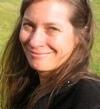|

Here in Tucson's persistent 100+ degree heat, it can be easy to skip a week of Nature's Notebook observations! But it's important to document a complete record of the growing season, to give a picture of what is happening with your plants and animals. I have a story to share with you about the confusion that can happen when summer observations are forgotten: The Ocotillo and the Hummingbird.
Many things can get in the way of your observations - summer trips, kid camps, not to mention the hot weather! Do what you can, and together we can continue to create a detailed record of plant and animal phenology across the US!
Happy summer observing!
|
|
What your data are telling us
|
How can tracking heat units help gardeners?
Heat units, or accumulated growing degree days, tell you how much heat a certain location has experienced. Plants in your garden have a requirement for the amount of heat they need before they leaf out or bloom. These requirements are the math behind planting guides.
But what happens when heat units accumulate faster in some years, or slower in others? How can a gardener know whether to adjust plant dates and by how much?
|
Video demos help you explore our new maps
We've added two new suites of maps to the USA-NPN Visualization Tool that allow you to look at trends in climate patterns. You can explore maps of accumulated growing degree days (often used to predict the timing of life cycle transitions) and the Spring Indices (an indicator of the "start of spring") to learn how spring unfolds in a particular year, how spring compares between years, and more.
|
What's new at Nature's Notebook and USA-NPN
|
New Phenophase Primer on the way 
Last year, we created the Botany Primer to help you understand the basic botany you need for Nature's Notebook. This fall, we'll be offering you a second Primer, this time focusing in-depth on the phenophases of Nature's Notebook. The new Primer will include an overview of the different functional groups, and a section on observing intensity of phenophases.
Stay tuned for more later this fall!
|
USA-NPN summer podcast series 
This summer, we're starting a new podcast series to give you an inside perspective on the lives of people who are involved in phenology in a variety of different ways. Our first podcast features an interview with Ellen Denny, the USA-NPN Monitoring Design & Data Coordinator.
She'll tell you about all the behind-the-scenes that goes into adding species to Nature's Notebook, how we choose the phenophases on the datasheets, and what she loves to observe the most.
|
|
Recent happenings in the field
|
Your observations validate satellite data
While there is great potential in linking data collected by observers on the ground and data collected by remote satellites, few studies have successfully combined them. Researchers from the Appalachian Laboratory at the University of Maryland Center for Environmental Science did just that, implementing quality
control procedures to combine observations of leaf phenology collected
satellite imagery collected by the Moderate Resolution Imaging
Spectrometer (MODIS).
|
| Nature's Notebook Nuggets |
 |
|  | Photo: Ellen G Denny |
Overwhelming phenophases: flowers and fruit
Seeing many different phenophases at once on your plant can make it difficult to understand when a phenophase has begun or ended. In the last Nature's Notebook Nugget, we talked you through how to wade through the chaos to make observations on leaf phenophases. In this Nugget, we focus on flowers and fruits.
|
|
More ways to get involved
|
Your computer can improve climate predictions
Did you know that your computer can be a citizen scientist too? Through climateprediction.net, you can let your computer run models to help with climate change research while you are not using it. Just load some simple software onto your computer, and it will run climate models while in sleep or idle mode. You and your computer can help improve predictions of what our climate will look like in the future.
|
 |
|  | Photo: Brian F Powell |
Audubon volunteers make a difference
Volunteers from the Madrone Audubon Society are observing birds and making a contribution to conservation science. An article in the Argus Courier describes how volunteers use their local knowledge to document changes in local bird populations at the Paula Lane Open Space Preserve through Nature's Notebook. This effort is part of BirdSeasons, a phenology project that includes multiple chapters of the California Audubon Society.
|
|
|
|